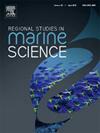Environmental magnetic signatures and textural profiling of rivers sediments: An assessment from Tamil Nadu’s East Coast, India
IF 2.1
4区 环境科学与生态学
Q3 ECOLOGY
引用次数: 0
Abstract
This study investigates an environmental magnetism and textural parameters on the Gadilam and Uppanar River sediments, specifically in the Cuddalore district of Tamil Nadu, India. There is a signifcant lack of research on the pollution study based on environmental magnetism unique to the Gadilam and Uppanar river sediments. Consequently, the purpose of the study mainly aimed to address the bonding of magnetic content and pollution status with the textural characteristics of the river sediments. Meticulous observation of the textural characteristics of the river sediments implies that Gadilam River sediments mainly consists of sand and silt, whereas the Uppanar river sediments dominantly comprises of sand compositions. Heavy metal concentration of Gadilam river arranges on Al > Fe > Ti > Mn > Zn > Cr > Cu > Ni > Pb, whereas the Uppanar River shows Al > Fe > Ti > Mn > Zn > Cr > Ni > Cu > Pb. The result shows low frequency of magnetic susceptibility of Uppanar River sediment indicates the higher magnetic susceptibility than Gadilam River sediment may due to influences of ferromagnetic components. Statistical analysis of this study illustrates, good relationship between the sand and silt fraction with the low-field magnetic frequency of the studied River sediments. The frequency dependence of Gadilam River sediments shows mixed grains, whereas the Uppanar River sediments indicating the no superparamagnetic grains. Also, the environmental contamination indices i.e. geoaccumulation index exhibits the heavy metals falls in the moderately polluted to extremely polluted category. This study demonstrates that environmental magnetism can be a convincing tool for rapid monitoring and qualitative assessment of pollution levels in urban rivers.
河流沉积物的环境磁特征和结构剖面:来自印度泰米尔纳德邦东海岸的评估
本研究调查了印度泰米尔纳德邦Cuddalore地区Gadilam和Uppanar河沉积物的环境磁性和结构参数。基于Gadilam河和Uppanar河沉积物特有环境磁性的污染研究明显缺乏。因此,研究的目的主要是为了解决河流沉积物的磁性含量和污染状况与纹理特征的结合。对河流沉积物结构特征的细致观察表明,Gadilam河沉积物主要由砂和粉砂组成,而Uppanar河沉积物主要由砂组成。重金属的浓度Gadilam河安排基地祝辞 Fe祝辞 Ti祝辞 Mn祝辞 锌祝辞 Cr祝辞 铜祝辞 倪祝辞 Pb,而Uppanar河显示Al祝辞 Fe祝辞 Ti祝辞 Mn祝辞 锌祝辞 Cr祝辞 倪祝辞 铜祝辞 Pb。结果表明,乌帕纳尔河沉积物磁化率较低,表明乌帕纳尔河沉积物磁化率高于加迪兰河沉积物,这可能是受铁磁成分的影响。本研究的统计分析表明,研究的河流沉积物的低磁场频率与砂粉含量有良好的关系。Gadilam河沉积物的频率依赖表现为混合颗粒,而Uppanar河沉积物的频率依赖表现为无超顺磁颗粒。环境污染指数即地积累指数表明,重金属处于中度污染至重度污染范畴。该研究表明,环境磁力可以作为快速监测和定性评价城市河流污染水平的有力工具。
本文章由计算机程序翻译,如有差异,请以英文原文为准。
求助全文
约1分钟内获得全文
求助全文
来源期刊

Regional Studies in Marine Science
Agricultural and Biological Sciences-Ecology, Evolution, Behavior and Systematics
CiteScore
3.90
自引率
4.80%
发文量
336
审稿时长
69 days
期刊介绍:
REGIONAL STUDIES IN MARINE SCIENCE will publish scientifically sound papers on regional aspects of maritime and marine resources in estuaries, coastal zones, continental shelf, the seas and oceans.
 求助内容:
求助内容: 应助结果提醒方式:
应助结果提醒方式:


